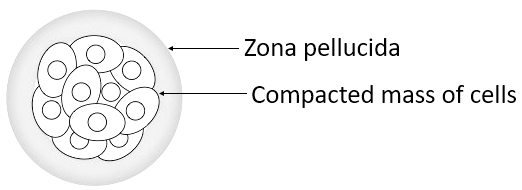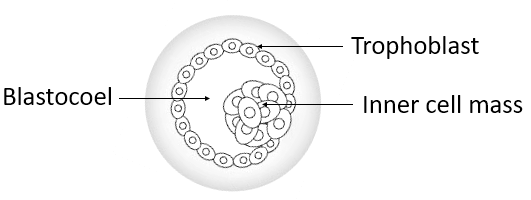
What is the difference between Morula and Blastula?
Answer
508.3k+ views
Hint: The Morula and Blastula are the two different stages during embryonic development of animals and both consist of different numbers of cells. One of them consists of a fluid-filled cavity that is absent in the other one.
Complete answer:
The difference between Morula and Blastula is as follows –
Morula – It is a stage in the embryonic development that occurs after cleavage in the zygote. It is a 16 celled stage that may occasionally contain 32 cells. The Zona pellucida layer of the egg is still present at this stage and it forms the outer cover of the Mourla. In the process of further development, it undergoes compaction. Here, the outer cells are smaller with tight junctions while the inner cell mass is slightly larger and rounded and has a gap junction. Morula descends slowly towards the uterus in about 4-6 days and corona radiata detaches during this period. A Morula has been shown below –

Blastula – It is a 64 celled stage which contains a fluid-filled cavity known as blastocoel and is the next stage in embryonic development after the Morula. This embryo is known as a blastocyst and consists of an inner cell mass that is attached to the embryonic or animal pole and an outer covering of the cells called trophectoderm or trophoblast. The opposite side of the animal pole is known as the abembryonic pole. The figure representing a blastula is given below –

Note:
-The formation of blastocoel converts Morula and Blastula.
-The blastula is called blastocyst in mammals because of the different nature of the surface layer and eccentric inner cell mass.
-The blastula with blastocoel is called coeloblastula.
Complete answer:
The difference between Morula and Blastula is as follows –
Morula – It is a stage in the embryonic development that occurs after cleavage in the zygote. It is a 16 celled stage that may occasionally contain 32 cells. The Zona pellucida layer of the egg is still present at this stage and it forms the outer cover of the Mourla. In the process of further development, it undergoes compaction. Here, the outer cells are smaller with tight junctions while the inner cell mass is slightly larger and rounded and has a gap junction. Morula descends slowly towards the uterus in about 4-6 days and corona radiata detaches during this period. A Morula has been shown below –

Blastula – It is a 64 celled stage which contains a fluid-filled cavity known as blastocoel and is the next stage in embryonic development after the Morula. This embryo is known as a blastocyst and consists of an inner cell mass that is attached to the embryonic or animal pole and an outer covering of the cells called trophectoderm or trophoblast. The opposite side of the animal pole is known as the abembryonic pole. The figure representing a blastula is given below –

Note:
-The formation of blastocoel converts Morula and Blastula.
-The blastula is called blastocyst in mammals because of the different nature of the surface layer and eccentric inner cell mass.
-The blastula with blastocoel is called coeloblastula.
Recently Updated Pages
Why are manures considered better than fertilizers class 11 biology CBSE

Find the coordinates of the midpoint of the line segment class 11 maths CBSE

Distinguish between static friction limiting friction class 11 physics CBSE

The Chairman of the constituent Assembly was A Jawaharlal class 11 social science CBSE

The first National Commission on Labour NCL submitted class 11 social science CBSE

Number of all subshell of n + l 7 is A 4 B 5 C 6 D class 11 chemistry CBSE

Trending doubts
10 examples of friction in our daily life

One Metric ton is equal to kg A 10000 B 1000 C 100 class 11 physics CBSE

Difference Between Prokaryotic Cells and Eukaryotic Cells

1 Quintal is equal to a 110 kg b 10 kg c 100kg d 1000 class 11 physics CBSE

State the laws of reflection of light

Explain zero factorial class 11 maths CBSE




